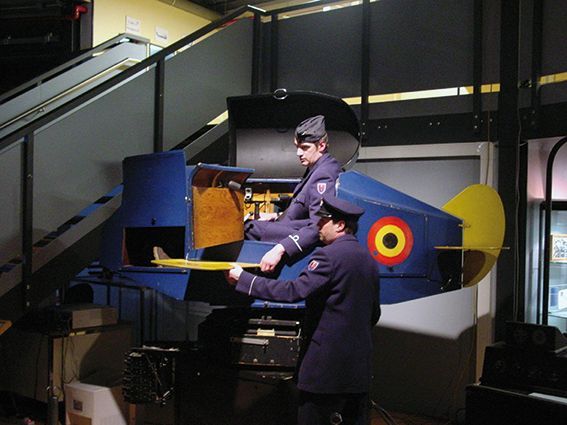
Link-Trainer
The name LINK trainer, also known as “Blue box” and “Sweat box” is used for a series of flight simulators built by Link Aviation Devices Inc. between 1930 and 1950. The firm was founded by Ed Link.
During World War II, the LINK trainers were used by almost all allied countries for the training of their pilots.
The first LINK trainer was built in 1929 in response to a need to safely teach pilots instrument flying. Ed Link then worked in his father's organ factory and was therefore well aware of bellows, pumps and valves.
More than 500,000 American pilots have received training on the LINK trainer.
More than 10,000 “Blue Boxes” were built during the war years. The ones built between 1934 and 1940 were blue in color with yellow wings. Later, those wings were omitted due to a shortage of materials.
The “pilot-to-be” is supposed to fly - virtually - a number of figures according to the instructions given by an instructor sitting at the desk behind the simulator. The executed movements are registered here by means of a plotter. The pupil will soon find that that line is never where he thought it would be.
Practice makes perfect...
The first LINK trainer lesson.
The LINK trainer is enthroned in a spotless room, in the middle of a shiny parquet floor. This strange device that is used for teaching blind flying. The new students, who watch the aircraft with curiosity from outside the building and press their noses against the window glass, soon find that it is closely related to a real aircraft. But, when called to the LINK for the first time, it is with a certain caution that they approach the device, because they remember very well the remarks of the "oldies" about the control difficulties of this rig. However, seeing the padded seat and the classic controls with which they are already familiar, they are quickly reassured. Everyone wishes to be the first for the first lesson. The instructor switches on the power, the most daring of the group settles into the chair and soon he can no longer resist the urge to use the stick and the controls.
The reaction of the teacher is not long in coming. He strongly disapproves of this premature initiative, though in his heart he hopes that the new student will display a lasting enthusiasm for flying blind. He then elaborates on the role of the instruments, their operation and method of use.
“Always compare the different instruments; you will then be sure of a correct reading.... Remember that the stick controls the "air-speed", the throttle, the variometer... Always keep an eye on the artificial horizon, because that is your main instrument..."
The instructor clears the device and invites the student to handle the controls.
“It's easy, isn't it, young man? The LINK is controlled in the same way as a real aircraft.”
Satisfied with himself for his good attitude to the controls, the student puffs out his chest and his heart swells with joy, convinced that he already knows all the tricks of blind flying.
For example, for 10 minutes, in the open air, without difficulty in controlling, he will learn to follow an airliner with ease and learn to turn correctly. Then, when the instructor judges that he is already sufficiently familiar with the device, he lowers the hood. The student is now suddenly in the dark. He only sees the luminous dials and the dancing hands.
The phenomenon specific to the first lesson is already making itself felt and soon becomes stronger and stronger. The "false plane" shakes with increasing vehemence, assumes odd attitudes, dives, prances, turns on itself like a drunken thug.
The teacher telephones his pupil and tries to inhibit the student's reactions.
“Check your reflexes… think… remember that the “stick” controls the speed and the gases the altitude… the LINK is extremely sensitive, handle it very gently…”
The student's voice vibrates in the headphones: “I don't know what to do anymore. The control hands are spinning crazy!”
“You're not crazy,” the teacher grunts without anger, “keep calm. We will start again tomorrow.”
Tomorrow the student will impose more balanced movements on the LINK. And each new perseverance will bring him closer to this delicate science of "blind flight" which will later be his best protection.
Adjutant Airman 1st class LEJEUNE
Instructor at the Elementary Flying School






